10 essential email marketing tips to boost your campaigns
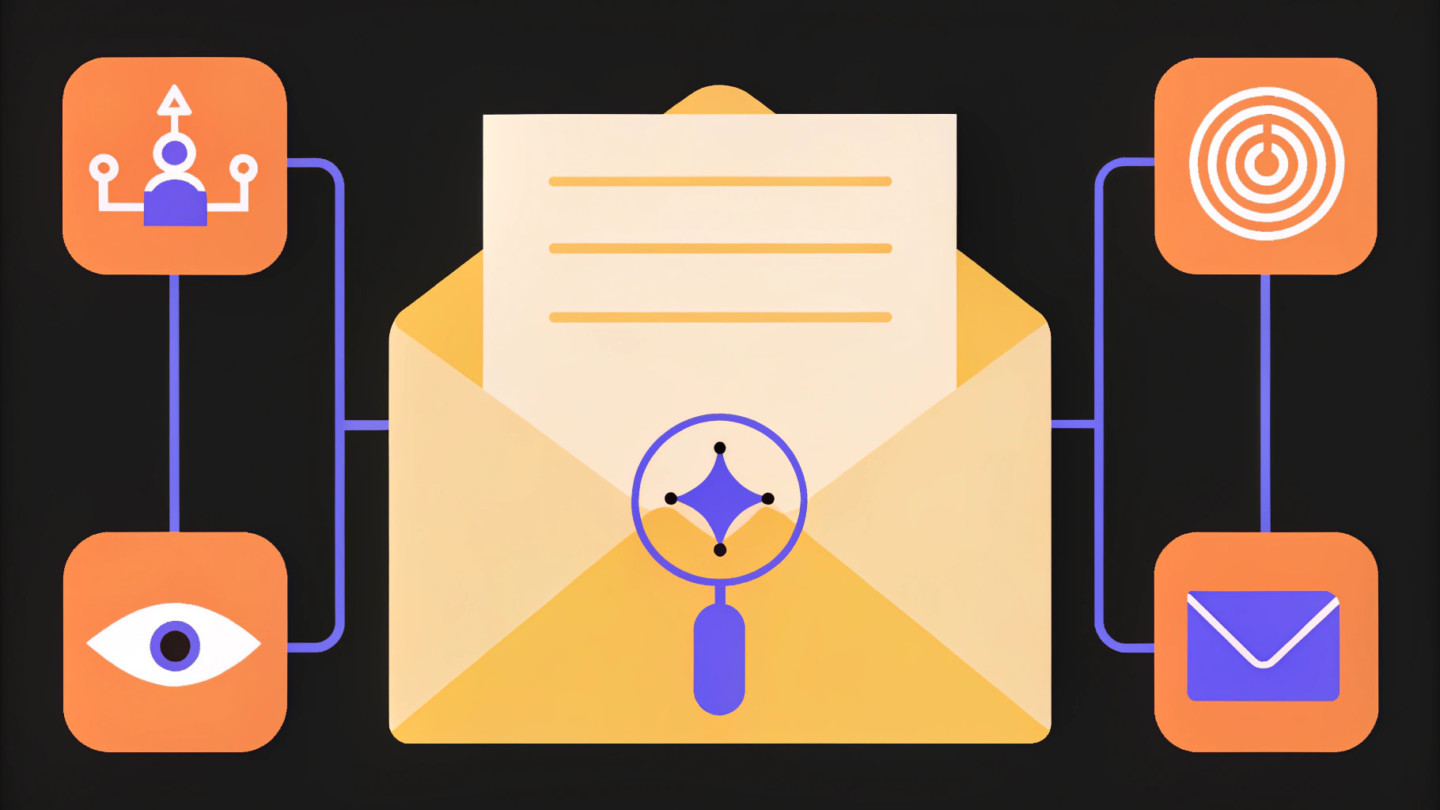
Introduction
Email marketing has emerged as a cornerstone strategy for businesses aiming to foster customer relationships and drive sales in a competitive digital landscape. By delivering tailored messages directly to a targeted subscriber list, organizations can effectively promote products and enhance engagement. This article delves into the fundamental aspects of email marketing, including:
- The importance of building a quality email list
- Crafting compelling content
- Analyzing campaign performance
It also explores key strategies for successful campaigns, including:
- The power of personalization and segmentation
- The critical role of compliance with regulations
Understanding these elements is essential for marketers looking to harness the full potential of email marketing in today’s evolving market.
Understanding the basics of email marketing
Email marketing isn’t just a tactic; it’s a game-changing strategy. Think of it like having a direct line to your customers. You’re sending tailored messages to your subscriber list, aiming to promote products, boost engagement, and nurture leads. This approach is proven to strengthen customer relationships and drive sales like nothing else.
Let’s break down the essentials of a successful email marketing strategy:
Build a quality subscriber list: Your subscriber list is your lifeblood. If it’s not targeted and engaged, your campaigns will struggle. The effectiveness of your outreach often hinges on who you’re reaching out to.
Create engaging content: Content is king, but only if it’s compelling. You want to resonate with your audience, grab their attention, and spark interaction. Here’s a staggering fact: in 2023, 52% of buyers made purchases directly from emails. That’s a clear signal — value-oriented content is non-negotiable.
Evaluate campaign outcomes: You can’t manage what you don’t measure. Keep an eye on key metrics like open rates and click-through statistics. Industry data for 2024 shows that open rates vary by sector, so you need to tailor your strategies accordingly.
Staying ahead of technology trends in marketing is essential for connecting with your audience. Digital communication strategies are outpacing social media interactions — 13% more effective than social media posts, and 11% better than social media ads. This isn’t just noise; it’s a clear indicator that email remains a powerhouse for marketers.
And here’s the kicker: a compelling case study reveals that 30% of marketers believe email marketing delivers the highest ROI among digital channels, with an impressive return of $36 for every $1 spent.
These statistics aren’t just numbers; they underscore the importance of mastering the fundamentals of digital communication. If your organization wants to harness this powerful tool, you need to get the basics right. It’s not just about sending emails; it’s about sending the right emails to the right people.
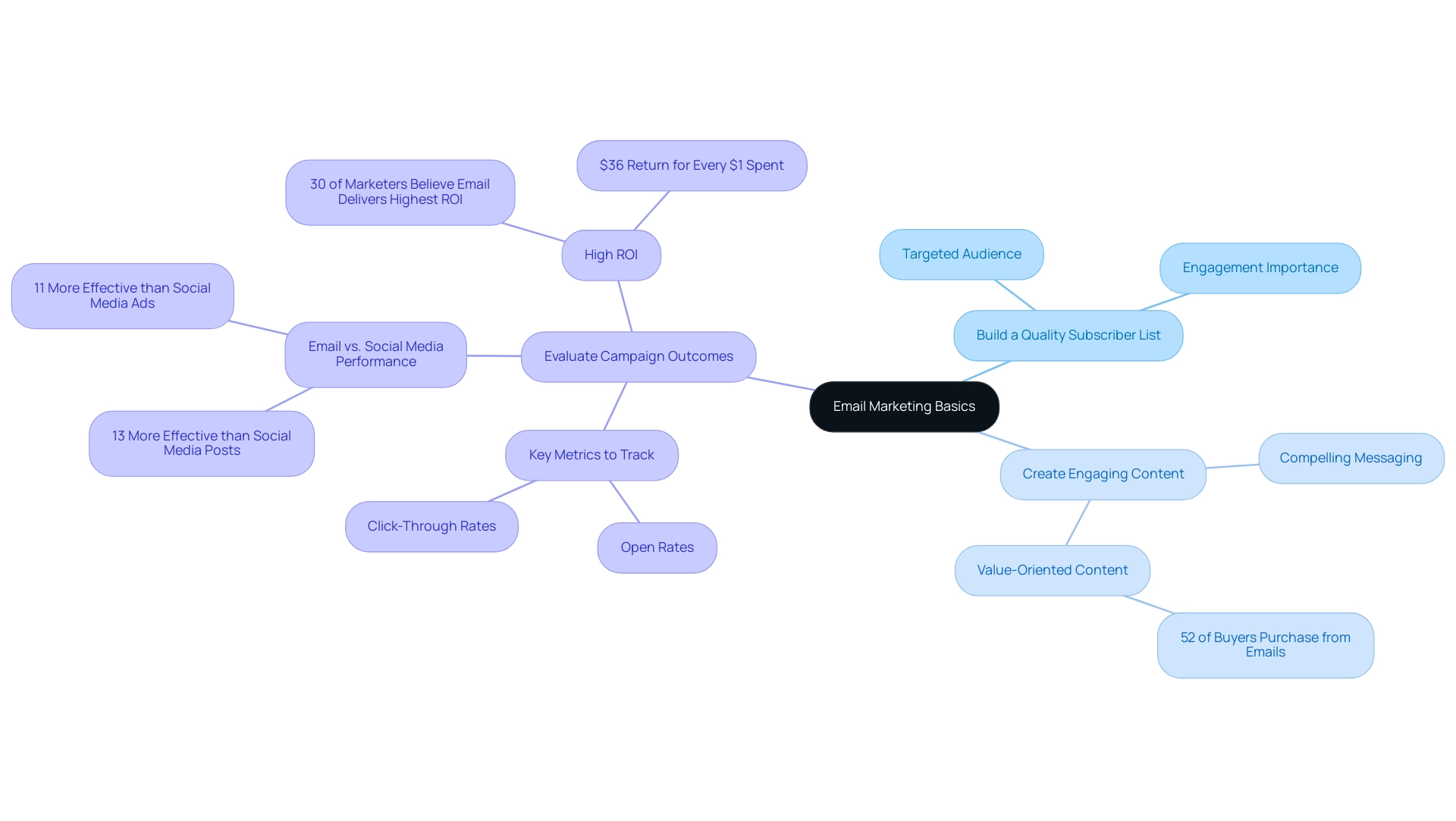
Key strategies for successful email campaigns
Successful email marketing is like running a well-tuned machine. Each part needs to function seamlessly to drive results. Here are some straightforward tips to help you create campaigns that really work.
Define clear goals: What’s your target? Is it boosting sales, driving traffic, or building brand awareness? Without clear goals, you’re like a ship without a compass. Research shows that 80% of business professionals agree that effective messaging enhances customer retention. So, keep your focus sharp.
Craft compelling subject lines: Think of your subject line as the front door to your email. If it doesn’t invite people in, they’ll walk right past. Subject lines can make or break your open rates. Try adding emojis or GIFs — they resonate well with millennials, who prefer these features 68% of the time. Make that first impression count.
Develop quality content: Don’t just fill space — deliver value. Whether it’s informative content, promotions, or exclusive offers, quality is crucial. If your content doesn’t engage, you risk losing your audience. Remember, the goal is to drive action, and that starts with what you say.
Optimize for mobile: Here’s a hard truth: 55% of emails are opened on mobile devices. If your emails aren’t mobile-friendly, you’re asking for trouble. Nearly 20% of campaigns that miss this mark lead to deletions by 42% of users. Plus, 56% of marketers are already using mobile-friendly strategies. Don’t get left behind — optimizing your emails can boost click-through rates by 15%.
Schedule wisely: Timing is everything. Experiment with different send times to find what resonates with your audience. With 43% of marketers adjusting their strategies due to Apple’s Mail Privacy Protection, staying on top of these changes is crucial. Adaptation is key to maximizing your campaign’s effectiveness.
In the end, email marketing is about understanding your audience and delivering what they want when they want it. Get these basics right, and you’ll be well on your way to successful campaigns.
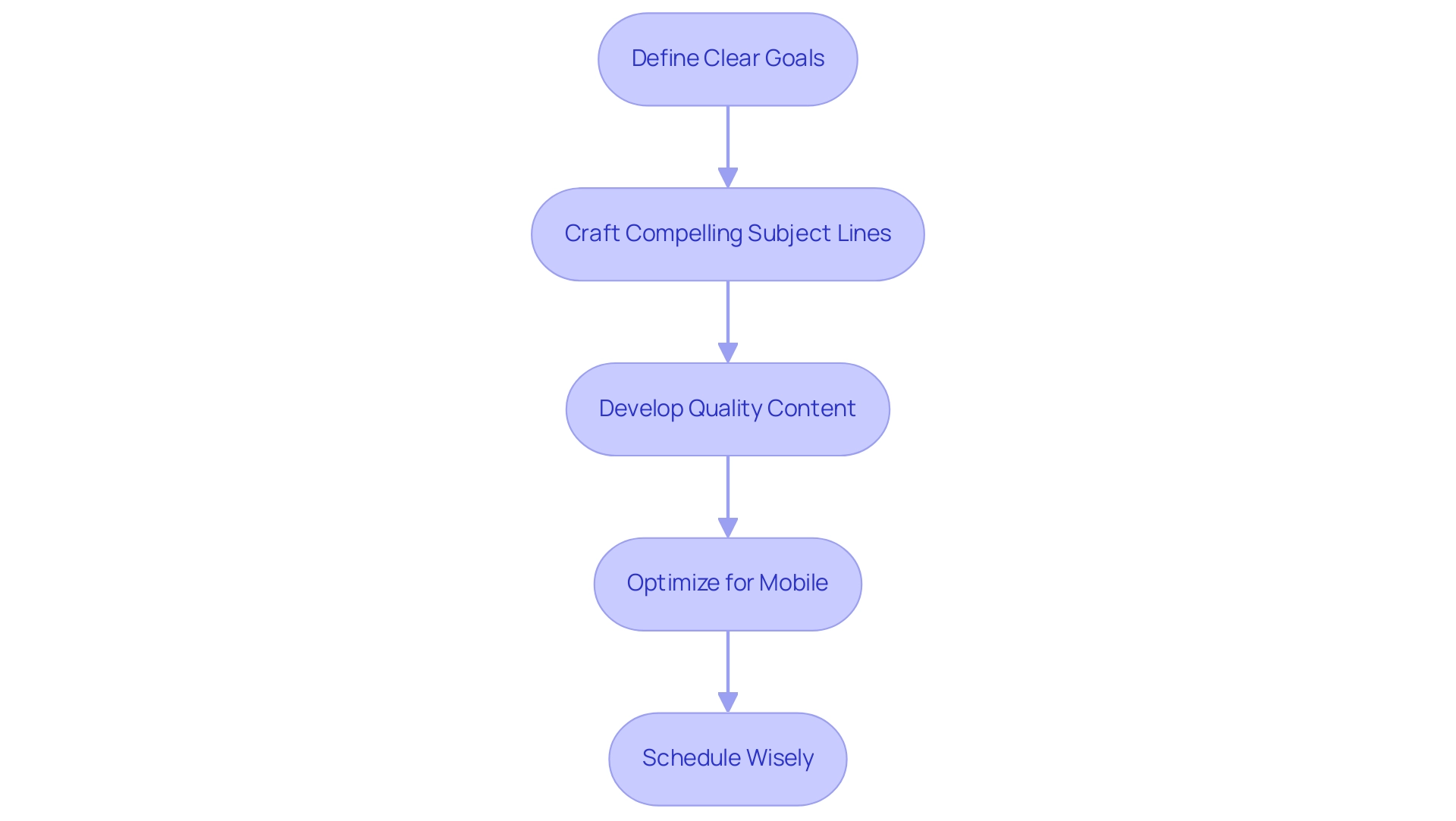
The power of personalization and segmentation
Email marketing isn’t just about sending out messages; it’s about making those messages count. Personalization and segmentation are your best friends in this game. Think of personalization as a handshake — it’s about addressing your subscribers by name and tailoring your content based on their purchase history and preferences. It’s the difference between a generic flyer and a targeted offer that makes someone feel special.
Now, segmentation is where you really start to get strategic. It’s like sorting your toolbox: you wouldn’t use a hammer when you need a screwdriver. By categorizing your contact list into groups based on demographics, behaviors, or how engaged they are, you can send the right message to the right people. For example, a retail brand might roll out a special promotion for first-time buyers that’s completely different from what they send to loyal customers. This strategy not only boosts open rates but also conversion rates.
But here’s the kicker: a lot of companies are missing the mark on localization. A recent report revealed that in 2022, 52.6% of marketers didn’t bother to send messages in the local language. That’s a big oversight. If you want to engage your audience, you need to speak their language — literally. A case study showed that language personalization can significantly enhance consumer engagement, yet many businesses are still lagging behind in this area.
Moving forward, it’s clear that personalizing your email marketing isn’t just a nice-to-have; it’s a must-have if you want to stay competitive in 2024 and beyond.
And don’t forget the timing. Data shows that Tuesdays are the sweet spot for sending emails, while Sundays? Not so much. Understanding when to hit send can make all the difference in your marketing strategy. So, get personal, get segmented, and get your timing right. That’s how you win in the email marketing game.
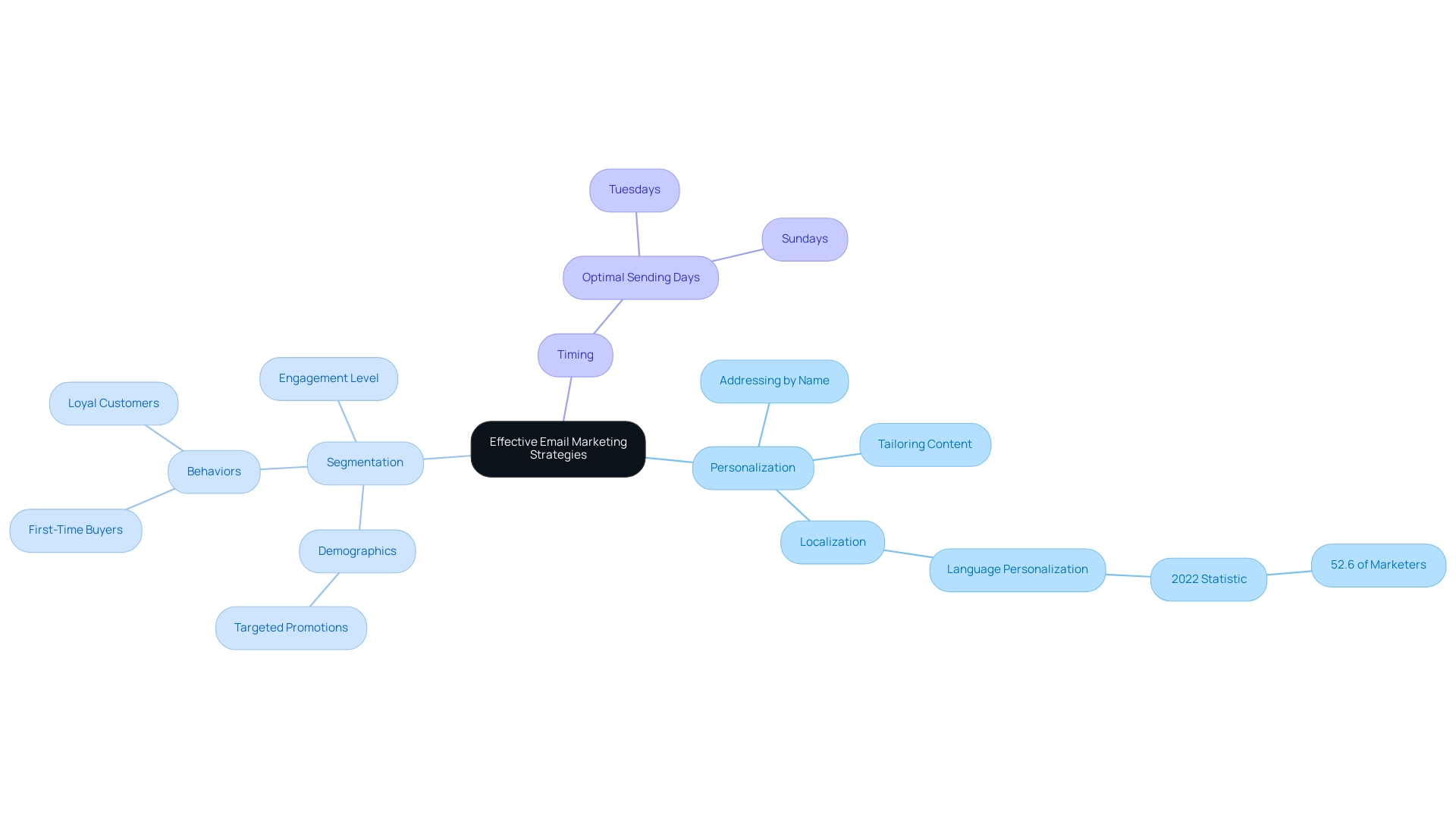
Optimizing campaigns through A/B testing and analytics
Email marketing isn’t just about sending out messages and hoping for the best. If you want to see real results, you need to get serious about A/B testing and analytics. Here’s the deal: A/B testing means you send two different versions of your email to separate segments of your audience. This way, you can see which version works better. Focus on testing the big hitters like subject lines, content layout, and call-to-action buttons.
But don’t stop there. You’ve got to dive into the numbers. Look at your open rates, click-through rates, and conversion rates. Here’s a surprising stat: B2B outreach messages enjoy a 23% higher click-to-open ratio compared to B2C messages. That’s a big deal. It shows how crucial it is to tailor your approach. Use these insights to refine your email marketing strategy, make informed decisions, and keep improving. Your audience is always changing, and your tactics need to keep pace.
In 2023, we saw that brand messages on platforms like LinkedIn can dramatically boost conversion chances. Users are six times more likely to engage with your content there. That’s a game changer. And don’t forget to revisit your A/B test results periodically. The case study ‘Repeat Tests to Confirm Results’ emphasizes this point. If you want your findings to stay relevant, you’ve got to keep checking in.
So, remember: A/B testing and analytics aren’t just nice-to-haves; they’re essential tools for enhancing your email marketing game. They help you fine-tune your campaigns and ensure you’re hitting the mark with your audience.
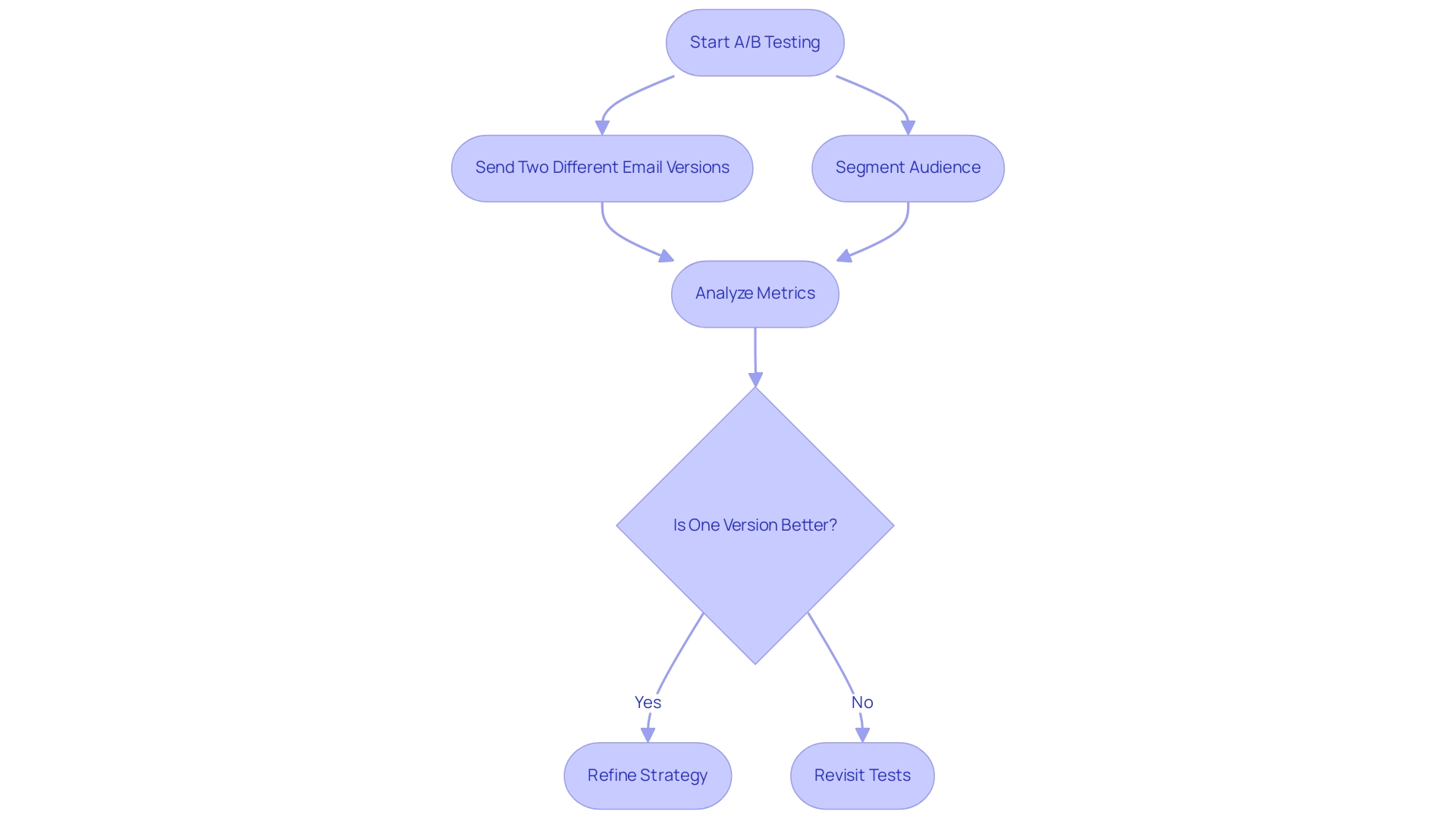
Compliance and best practices for email marketing
In digital marketing, following the rules isn’t just a checkbox; it’s a necessity. Adhering to regulations like the CAN-SPAM Act and GDPR is crucial. You can’t just send messages out into the void. You need explicit consent from your subscribers first. And when they want out? Make it easy for them to unsubscribe. No one likes a complicated exit.
Every email should also include your physical address. Transparency isn’t just nice to have; it’s essential when it comes to using subscriber data. Think of it as building a house — if the foundation is shaky, the whole structure is at risk.
Now, let’s talk about best practices. Keeping a clean contact list is like maintaining a well-tuned engine. If you don’t honor subscriber preferences, you’re asking for trouble. Misleading subject lines? That’s a fast track to losing trust. A statistic shows that 27% of security and IT professionals say mitigating internal audit fatigue is their top compliance challenge. This paints a picture of a complex compliance landscape.
And here’s another nugget: 35% of business and tech executives consider third-party breaches a major cyber threat, with 28% feeling unprepared to tackle it. This isn’t just a statistic; it’s a wake-up call. Strong compliance practices in your marketing communications are not optional — they’re critical.
Consider the case study on email automation and segmentation. Only 37% of emails are automated, yet the Entertainment industry sees double the open rates when targeting segmented audiences, according to DMA and Netcore. That’s a clear lesson: if you want to build trust and minimize legal risks, you need to be smart about your email marketing strategies. Follow these tips, and you’ll not only comply but thrive.
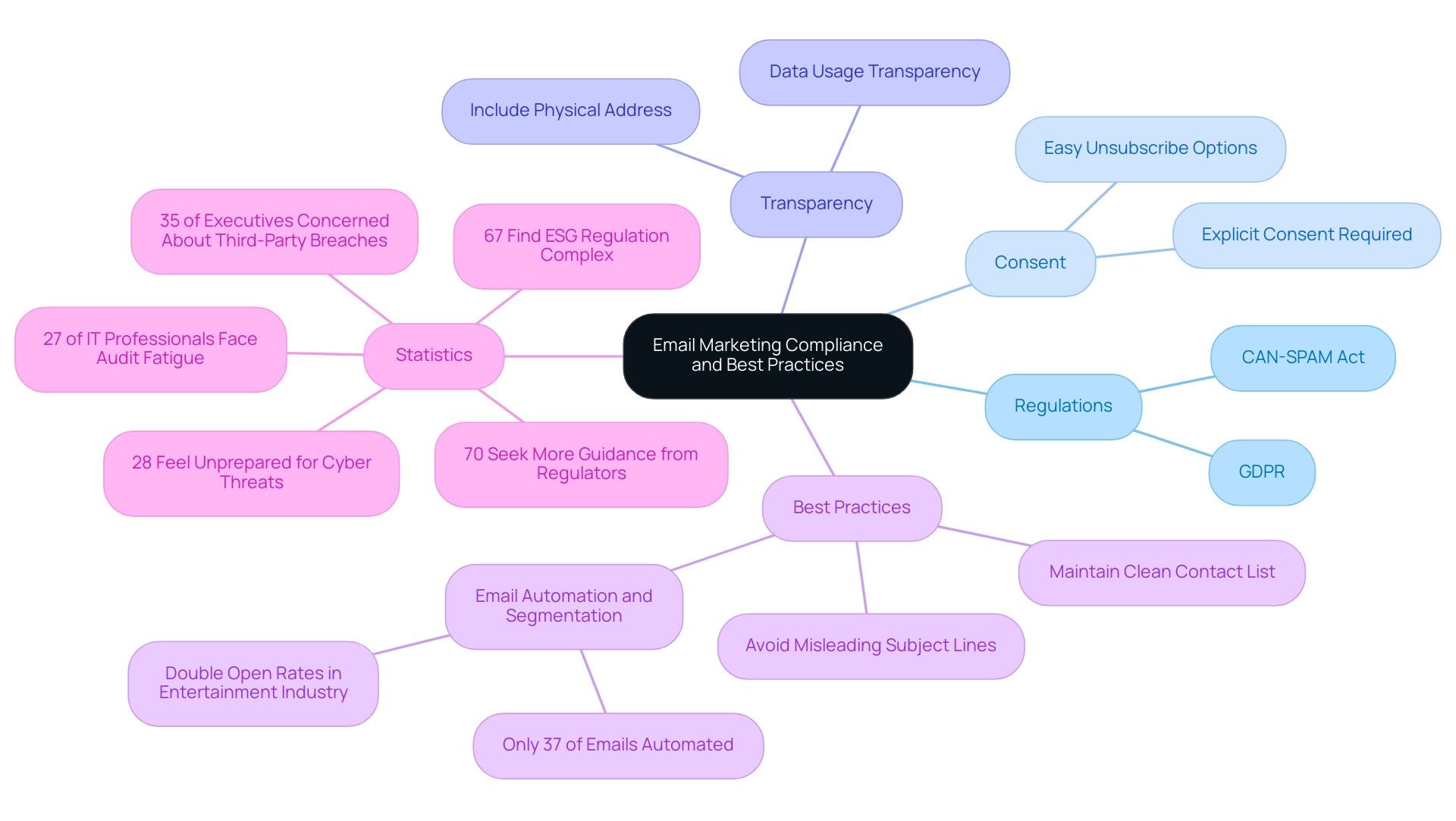
Conclusion
Email marketing stands out as a vital strategy for businesses seeking to cultivate customer relationships and increase sales. The article emphasizes the importance of:
- Building a quality email list
- Creating engaging content
- Analyzing campaign performance to ensure success
By focusing on these foundational elements, marketers can effectively connect with their audience and drive meaningful engagement.
Key strategies such as personalization and segmentation further enhance the effectiveness of email campaigns. Tailoring messages to individual subscribers and categorizing audiences based on specific criteria allow for more relevant communications, which in turn boosts open and conversion rates. Additionally, implementing A/B testing and leveraging robust analytics ensures continuous improvement, enabling marketers to refine their approaches based on data-driven insights.
Compliance with regulations like the CAN-SPAM Act and GDPR remains crucial in maintaining trust and avoiding legal pitfalls. By adhering to best practices and ensuring transparency with subscribers, businesses can foster a positive relationship with their audience. As the digital landscape continues to evolve, mastering these email marketing fundamentals will be essential for organizations aiming to thrive in a competitive market. Embracing these strategies not only enhances campaign performance but also positions businesses for long-term success in their email marketing efforts.



![21 proven tools for your 2025 marketing tech stack [Recommended by market experts]](https://www.dashly.io/blog/wp-content/uploads/2022/08/martech-stack-999-720x317.png)


![La guía definitiva de growth marketing [explicada por un growth hacker]](https://www.dashly.io/blog/wp-content/uploads/2023/04/The-ultimate-guide-to-growth-marketing-explained-by-a-growth-hacker-720x317.png)
